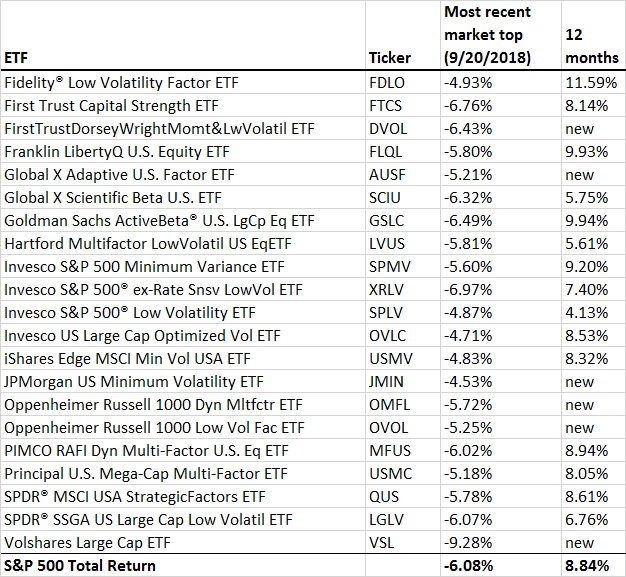Low-Volatility ETFs Are Doing Their Job
These funds made a stomach-churning week easier to swallow


Many low-volatility ETFs are actually doing what they promised: delivering smaller losses in down markets.
The idea behind low-vol funds: Buy stocks with the lowest up-and-down moves. In theory, these stocks will suffer less in a down market.
Two important corollaries to the theory:
From just $107.88 $24.99 for Kiplinger Personal Finance
Become a smarter, better informed investor. Subscribe from just $107.88 $24.99, plus get up to 4 Special Issues

Sign up for Kiplinger’s Free Newsletters
Profit and prosper with the best of expert advice on investing, taxes, retirement, personal finance and more - straight to your e-mail.
Profit and prosper with the best of expert advice - straight to your e-mail.
- They also will tend to rise less in up markets. Risk and return are joined at the hip: If you want lower volatility when the market is down, you’ll get it when the market is up, too.
- They still will fall in a down market. These are, after all, stock ETFs, and when the broad market falls, they will swoon along with it. Don’t buy one of these if you can’t stand to see your investment fall in value at all.
Because these funds are less volatile, you’re less likely to panic and sell in a downturn. And, because your losses will be smaller than a garden-variety ETF, you should return to profitability faster than an ETF that simply tracks the Standard & Poor’s 500-stock index.
Special mention should be made of these three low-vol ETFs:
- Fidelity Low Volatility Factor ETF (FDLO, $31.91) has fallen 4.93% since the S&P 500’s Sept. 20 high, while the index has tumbled 6.08%. The past 12 months the fund is up 11.59%, vs. 8.84% for the S&P 500.
- Franklin LibertyQ U.S. Equity ETF (FLQL, $29.86), down 5.80% since the market high and 9.93% for the past 12 months.
- Invesco S&P 500 Minimum Variance ETF (SPMV, $29.02), down 5.60% since the market high and 9.20% for the past 12 months.
Look carefully to see how the ETFs construct their portfolios. Invesco S&P 500 Low Volatility ETF (SPLV, $47.35), for example, simply invests in the 100 least volatile S&P 500 stocks and gives the least volatile stocks the highest weighting. The fund reconstitutes its holdings every quarter.
iShares Edge MSCI Min Vol USA ETF (USMV, $54.11) uses the MSCI USA Index, a somewhat more comprehensive index that includes mid-cap names. The fund picks the least volatile stocks within each industry sector, ensuring greater diversification.
Here’s the rundown on large-company blend low-volatility ETFs and how they have performed as of Oct. 11. Dividends and gains are reinvested. Data via Morningstar.

Profit and prosper with the best of Kiplinger's advice on investing, taxes, retirement, personal finance and much more. Delivered daily. Enter your email in the box and click Sign Me Up.

-
 Why Public Markets Don't Look Like They Used To
Why Public Markets Don't Look Like They Used To -
 Turning 65 in 2026? Here Is Exactly How to Sign Up for Medicare
Turning 65 in 2026? Here Is Exactly How to Sign Up for MedicareWhether you’re months away from your 65th birthday or plan to work past retirement age, here are the steps to secure your Medicare coverage and avoid costly mistakes.
-
 A Free Tax Filing Option Has Disappeared for 2026: Here's What That Means for You
A Free Tax Filing Option Has Disappeared for 2026: Here's What That Means for YouTax Filing Tax season officially opens on January 26. But you'll have one less way to submit your tax return for free. Here's what you need to know.
-
 Stocks See First Back-to-Back Losses of 2026: Stock Market Today
Stocks See First Back-to-Back Losses of 2026: Stock Market TodayRising geopolitical worries and a continued sell off in financial stocks kept pressure on the main indexes on Wednesday.
-
 Visa Stamps the Dow's 398-Point Slide: Stock Market Today
Visa Stamps the Dow's 398-Point Slide: Stock Market TodayIt's as clear as ever that President Donald Trump and his administration can't (or won't) keep their hands off financial markets.
-
 Stocks Climb Wall of Worry to Hit New Highs: Stock Market Today
Stocks Climb Wall of Worry to Hit New Highs: Stock Market TodayThe Trump administration's threats to Fed independence and bank profitability did little to stop the bulls on Monday.
-
 Dow Hits a Record High After December Jobs Report: Stock Market Today
Dow Hits a Record High After December Jobs Report: Stock Market TodayThe S&P 500 also closed the week at its highest level on record, thanks to strong gains for Intel and Vistra.
-
 Nasdaq Takes a Hit as the Tech Trade Falters: Stock Market Today
Nasdaq Takes a Hit as the Tech Trade Falters: Stock Market TodayThe Dow Jones Industrial Average outperformed on strength in cyclical stocks.
-
 Dow Hits New High Then Falls 466 Points: Stock Market Today
Dow Hits New High Then Falls 466 Points: Stock Market TodayThe Nasdaq Composite, with a little help from tech's friends, rises to within 300 points of its own new all-time high.
-
 Dow, S&P 500 Rise to New Closing Highs: Stock Market Today
Dow, S&P 500 Rise to New Closing Highs: Stock Market TodayWill President Donald Trump match his Monroe Doctrine gambit with a new Marshall Plan for Venezuela?
-
 'Donroe Doctrine' Pumps Dow 594 Points: Stock Market Today
'Donroe Doctrine' Pumps Dow 594 Points: Stock Market TodayThe S&P 500 rallied but failed to turn the "Santa Claus Rally" indicator positive for 2026.